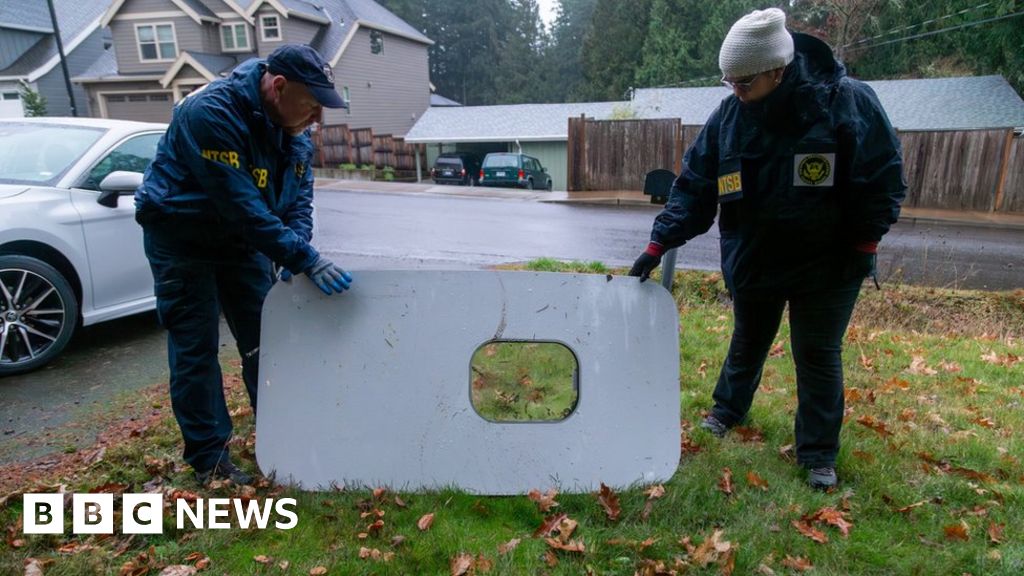The US National Transportation Safety Board (NTSB), which is leading an investigation into the incident, said pilots had reported pressurisation warning lights on three previous flights made by the specific Alaska Airlines Max 9 involved in the incident.
As bad as it is if a manufacturing issue caused a piece to fall off an airplane, there’s a huge amount of negligence in an airline continuing to fly an airplane that has triggered pressure warnings multiple times.m without investigating and resolving the issue.
Ex-aircraft mechanic here. Nothing will have been done in this situation without paperwork backing the decision. There are often small niggles that could ground an aircraft, but there are manuals that can be consulted to see how many more flights can be taken before it must be grounded for rectification - the MEL (minimum equipment list) and CDL (configuration deviation list). So the airline will not have made the ultimate decision to keep flying, Boeing will.
The fact that this has now been found in two different airlines means that it’s a design flaw again, either the locking mechanism on the bolts is insufficient, or the reinstallation instructions in the maintenance manual is incorrect (the Alaska airlines aircraft door plug was recently removed to carry out maintenance on another part)
As an airline customer, I would much rather have the airline tell me the plane was grounded due to parts being ready to fall off than the 3 hours I had to wait one time because of a busted tray table.
If it’s not in the MEL or CDL then you can’t fly without it. They’re basically a book of approvals for how long you can get away with stuff.
Btw If the tray table can’t be stowed, you can’t take off with anyone in that row because of the danger in an emergency landing.
Agreed. This is a multi-layered fuckup. The manufacturer probably didn’t tighten things down all the way, their QA didn’t catch the critical defect, the plane inspectors didn’t catch it during inspection, the airline didn’t ground it after a pressurization warning, the pilot flew a plane with a known issue. There are several cultures of complacency at play. Hopefully the FAA can scare everyone into flying right.
The reason I added the “if” is because I didn’t see any information about age and don’t know the specifics of the engineering/specs. Bolts needing the be checked annually and tightened every 5 on average could be perfectly reasonable with how much stress is on airplanes. There’s a reason frequent inspection is enforced more heavily on airplanes, and it’s not just because failures mean potentially falling out of the sky.
But yeah, it’s entirely possible they fucked up, but it’s for sure United did.
The plane was delivered in October so it was brand new
That’s helpful extra context. Then hard to argue Boeing didn’t shit the bed too.
I think you mean Alaska.
Yep. I can’t read.
Thanks.
And the next paragraph:
The jet had been prevented from making long-haul flights over water so that the plane “could return very quickly to an airport” in the event the warnings happened again, NTSB chief Jennifer Homendy said.
Which makes it sound like they couldn’t find the source of that warning but weren’t willing to completely write it off.
Lovely, I’m flying united to Ireland in two months. Fingers crossed I get an older version.
Ah, playin’ it safe, are ya? Why not spice things up a bit? Flyin’ United, might as well throw in a bit of turbulence for the craic!
Better you’re on the airline where they found the problems than the airline that didn’t.
MAX must stand for “MAX Profits” because they sure cut lots of corners on that aircraft.
I wonder how many cents they saved by not ensuring the bolts were properly tightened.
After looking at that diagram I have to ask - why in the everliving fuck would a pressure bearing panel like that be hung by bolts and not inserted into the cabin and held in place by the ribs of the fuselage? I mean seriously?
I don’t get why they don’t just make it a bit bigger on the inside so that when pressurized, the pressure itself seals it. Seems like a fail safe solution instead of this shadiness.
It is, kind of. The plug is secured by 6 stops (or tabs) along each side. The positive pressure differential pushes the plug outwards into those stops.
To remove the plug you uninstall 4 bolts which allow the plug to go up and over the stops, after which it can hinge outwards on a hinge found at the bottom of the plug.
But mah profits!
737 Max is still a developing example of what happens when you leave corporate to self-regulate themselves.
It’s a well documented that when Boeing merged with McDonald Douglas, they turned from an engineering led company to an executive led one & have been shit since
I think it’s to save space. See: DC-10 Cargo Door fiasco
That’s how the normal doors work because they aren’t permanently secured in place. The reason is weight as it pretty much always is in aviation design.
It’s a door plug, which means it’s meant to be replaced with an actual door if required, so a lot of the hardware for an actual door are in place. Doors are designed to slide in, then raise up so the stop pins engage the stop fittings from the inside, so the door is in effect bigger than the hole it’s in. this video provides a detailed explanation of how it works.
The big issue here is that the airplane is only 2 months old, it was delivered from Boeing in late October. Which means it’s either a design flaw or a process flaw in the original manufacturing. This smacks of corporate cost cutting again. Boeing are totally on the hook for this and it’s only lucky there were no lives lost. You watch, they’ll blame it on the airline initially but the fault will come back round to them again.
Here is an alternative Piped link(s):
this video provides a detailed explanation of how it works.
Piped is a privacy-respecting open-source alternative frontend to YouTube.
I’m open-source; check me out at GitHub.
This is the best summary I could come up with:
Bolts in need of “additional tightening” have been found during inspections of Boeing 737 Max 9s, United Airlines has said.
Inspections began after a section of the fuselage fell from an Alaska Airlines 737 Max 9 on Friday.
United Airlines said “installation issues” relating to door plugs would be “remedied” before the aircraft type would return to service.
In its statement, United said: “Since we began preliminary inspections on Saturday, we have found instances that appear to relate to installation issues in the door plug - for example, bolts that needed additional tightening.”
The door plug is a piece of fuselage with a window that can be used as an emergency exit in certain configurations.
It was this part of the Alaska Airlines plane which dramatically fell off mid-flight over the US state of Oregon, eventually landing in a teacher’s back garden.
The original article contains 204 words, the summary contains 142 words. Saved 30%. I’m a bot and I’m open source!






